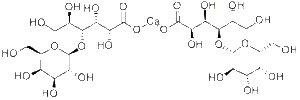| Anmol Chemicals is the pioneer manufacturers of Calcium Lactobionate, Pharmaceutical Excipients Fragrance & Flavor chemicals in India. We offer Halal and Kosher Calcium Lactobionate made in an ISO9001, ISO22000 (FSSC22000) cGMP and GLP certified facility. Our group has several manufacturing facilities spread across the world, supported by toll manufacturers and representatives in UAE, Europe, Africa, USA, China and has several associated manufacturing facilities spread across India. All the Information on Physics, Chemistry, Applications, Uses and Technology on Manufacture of Calcium Lactobionate is in these pages. |
| The units have one or more of the certifications like FDA GMP, ISO 9001, ISO 22000, HACCP, REACH, Kosher & Halal |





Calcium Lactobionate USP Grade Manufacturers
Calcium Lactobionate SDS GHS MSDS Sheet of Manufacturers
Calcium Lactobionate USP Grade
C24H42CaO24.2H2O -- 790.68
D-Gluconic acid, 4-O- -D-galactopyranosyl-, calcium salt (2:1), dihydrate.
Lactobionic acid, calcium salt (2:1), dihydrate.
Calcium lactobionate (1:2), dihydrate [110638-68-1].
Calcium Lactobionate contains not less than 96.0 percent and not more than 102.0 percent of C24H42CaO24.2H2O.
Identification
A: A solution (1 in 50) responds to the tests for Calcium.
B: Infrared Absorption 197K.
C: Dissolve a quantity of it in water to obtain a test solution containing 10 mg per mL. Similarly prepare a Standard solution of USP Calcium Lactobionate RS in water containing 10 mg per mL. Apply separately 5 :L of the test solution and 5 :L of the Standard solution to a suitable thin-layer chromatographic plate coated with a 0.25-mm layer of chromatographic silica gel. Dry the plate in a current of cool air. Place the plate in a suitable chromatographic chamber lined with filter paper and previously equilibrated with a solvent system consisting of a mixture of alcohol, water, ethyl acetate, and ammonium hydroxide (50:30:10:10). Develop the chromatogram until the solvent front has moved about three-fourths of the length of the plate. Remove the plate from the chamber, and dry at 100 for 20 minutes. Allow to cool, and spray with a spray reagent prepared as follows. Dissolve 2.5 g of ammonium molybdate in about 50 mL of 2 N sulfuric acid in a 100-mL volumetric flask, add 1.0 g of ceric sulfate, swirl to dissolve, dilute with 2 N sulfuric acid to volume, and mix. Heat the plate at 110 for about 10 minutes: the principal spot obtained from the test solution corresponds in color, size, and RF value to that obtained from the Standard solution.
Specific rotation: between +22.0 and +26.5 .
pH: between 5.4 and 7.4, in a solution (1 in 20).
Halides: A 1.2-g portion tested as directed under Chloride shows no more turbidity than corresponds to 0.7 mL of 0.020 N hydrochloric acid (0.04%).
Sulfate: A 2.0-g portion dissolved in boiling water shows no more sulfate than corresponds to 1 mL of 0.020 N sulfuric acid (0.05%).
Heavy metals: Mix 1 g with 4 mL of 1.2 N hydrochloric acid, add water to make 25 mL, warm gently until dissolved, and cool to room temperature: the limit is 0.002%.
Reducing substances: Transfer 1.0 g to a 250-mL conical flask, dissolve in 20 mL of water, and add 25 mL of alkaline cupric citrate. Cover the flask, boil gently for 5 minutes, accurately timed, and cool rapidly to room temperature. Add 25 mL of 0.6 N acetic acid, 10.0 mL of 0.1 N iodine VS, and 10 mL of 3 N hydrochloric acid, and titrate with 0.1 N sodium thiosulfate VS, adding 3 mL of starch as the endpoint is approached. Perform a blank determination, omitting the specimen, and note the difference in volumes required. Each mL of the difference in volume of 0.1 N sodium thiosulfate consumed is equivalent to 2.7 mg of reducing substances (as dextrose): the limit is 1.0%.
Assay
Dissolve about 0.8 g of Calcium Lactobionate, accurately weighed, in a mixture of water and 3 N hydrochloric acid (150:2). While stirring with a magnetic stirrer, add about 15 mL of 0.05 M edetate disodium VS from a 50-mL buret. Add 15 mL of 1 N sodium hydroxide and 300 mg of hydroxy naphthol blue, and continue the titration to a blue endpoint. Each mL of 0.05 M edetate disodium is equivalent to 39.53 mg of C24H42CaO24.2H2O.
For Original Monographs of IP Indian Pharmacopoeia BP British Pharmacopoeia USP US Pharmacopoeia FCC Food Grade product, please check with the respective web-pages or books.
Manufacturers
Anmol Chemicals
S-8, SARIFA MANSION, 2ND FLANK ROAD, CHINCHBUNDER, MUMBAI 400009, INDIA
TEL: (OFFICE) 91-22-23770100, 23726950, 23774610, 23723564. FAX: 91-22-23728264
e-mail: anmolc@mtnl.net.in

Exports to USA, Canada, UAE, Dubai, South Africa, Tanzania, Kenya, Nigeria, Egypt, Uganda, Turkey, Mexico, Brazil, Chile, Argentina, Europe Netherlands, Italy, Spain, Germany, Portugal, France, Malaysia, Indonesia, Thailand, Norway, Ukraine, Korea, Japan, etc.
Copyright and Usual Disclaimer is Applicable. 20 January, 2022
God grant me serenity to accept the things, I cannot change
Courage to change the things, I can change
And the wisdom to know the difference.